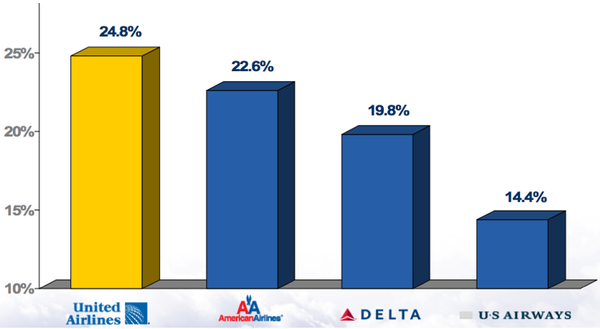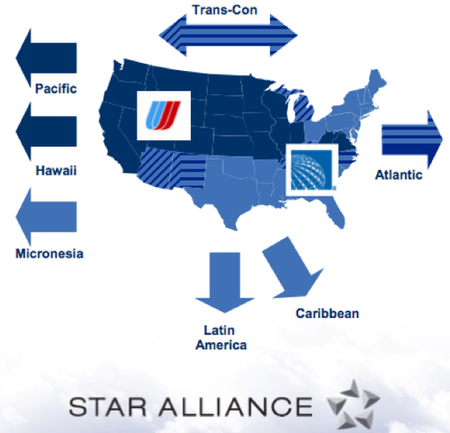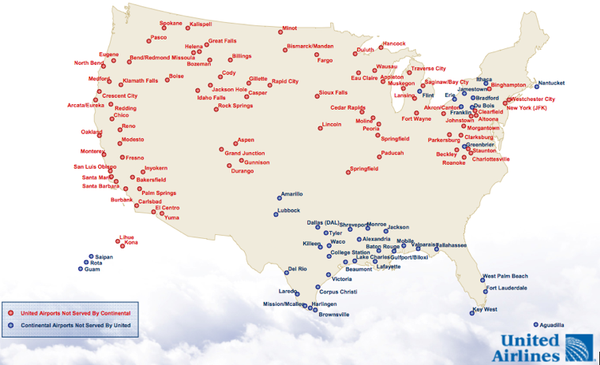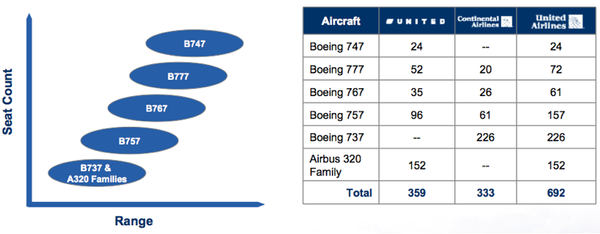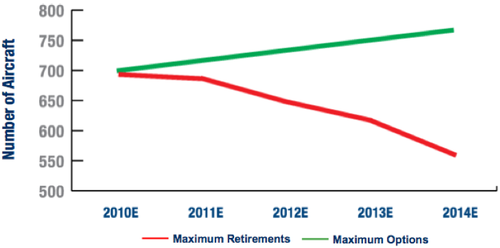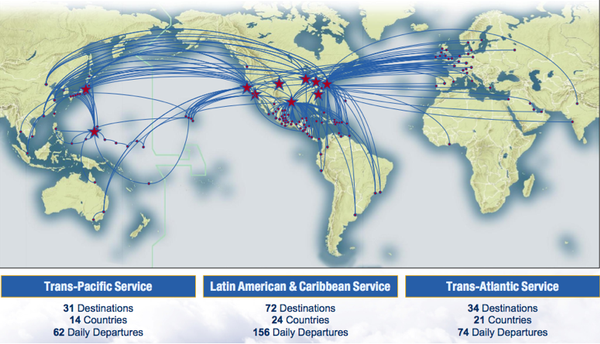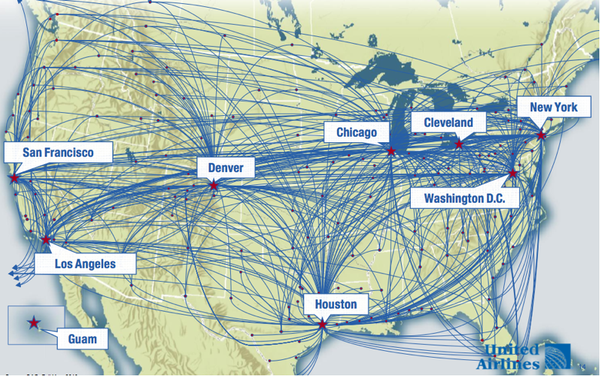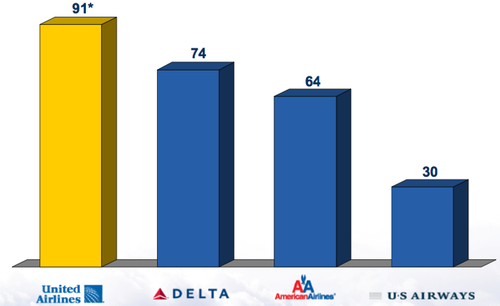United-Continental’s USD3 billion deal to yield USD1.2 billion in value - conservatively
Although stories over the weekend cautioned that a deal between United and Continental could fall apart just as it did two years ago, it was to no one's surprise that the two airlines announced their plans to merge in a USD3.1 billion, all-stock deal, based on Friday's stock prices, that will ultimately yield USD1 billion to USD1.2 billion in long-term value.
- United and Continental announce plans to merge in a $3.1 billion, all-stock deal, creating the world's largest airline.
- The merger is expected to yield $1 billion to $1.2 billion in long-term value.
- The combined carriers have industry-leading unit revenue, margin performance, and liquidity.
- Labour groups express caution and emphasize the need for broad employee support for the merger to be successful.
- The merger is expected to improve long-term career outlook and job stability for employees.
- The merger is seen as a strategic move to compete in a global marketplace and create a stronger, more efficient airline.
See related article: United-Continental: is bigger better, or does it just take longer to burn?
Continental CEO Jeff Smizek, briefing analysts and reporters during a joint webcast with United CEO Glenn Tilton, reiterated time and again these numbers were conservative. "The combined carriers have industry-leading unit revenue, industry-leading margin performance, and we have industry-leading liquidity at USD7 billion unrestricted cash balance," said Mr Smizek, who added that the airlines would be filing with both US and European regulatory authorities shortly and seeking shareholder approval in September with an expected closing date before year's end. "We went through a lot of this in 2008 and learned during alliance integration that some synergies we thought were obtainable were not and others are there that we had not previously imagined. That is why we are so excited about the potential. Analyzing the revenue synergies is profoundly complex, there are additional opportunities beyond that and we can bring all these synergies home."
EBITDAR margin (%) excluding special items - non-GAAP
Cash as a Percentage of Revenue: 12 months ended 31-Mar-2010
Labour wary, gives warning; merger needs "broad employee support"
New labour contracts are baked into the net synergy numbers. Indeed, Mr Smizek set a new tone for United labour relations, pledging to incorporate the Continental labor relations culture into United, which has been famous for the bitter battles between labour and management - to the point where, at least for pilots, happiness would be the ouster of Chairman and CEO, Glenn Tilton. Smizek has a tall order, since there hasn't been a United management group in the last couple of decades that pilots haven't wanted to oust. A real measure of success will be whether Mr Smizek joins that group or becomes the pilots' new best friend. As for where the labor market is today, the Continental head said that the Delta contracts seemed to be the sweet spot for now, noting Continental's recent offer to pilots that centred on the Delta contract plus USD1. "That is the appropriate contract for where the market is today," he said.
United's Air Line Pilots Association unit did not give the proposed merger a ringing endorsement, noting the risks involved, the necessity of pilot approval for merger success and the fact that the combined entity must result in a stronger airline than would otherwise be had with stand-alone carriers. Nor did it oppose the deal, as it had with the proposed US Airways merger.
"The pilots who fly for Continental and United are prepared to stand shoulder to shoulder to support the creation of a viable, profitable merged company," said United Master Executive Council Chair Wendy Morse in a statement. "The importance of a fair and equitable seniority integration between the two pilot groups and a businesslike commitment to achieving commensurate value for pilots through the prompt negotiation, among other things, of a new joint collective bargaining agreement is recognized by all parties as central to a successful airline merger. We are also prepared to stand shoulder to shoulder in opposition of this transaction should these ideals and concepts not immediately be fostered by the new management team. Both the United and Continental pilot groups understand what can be achieved by working together; and, in concert with the new management team, under these conditions welcome the opportunities and expected rewards of building a winning combination."
Mr Smizek noted that labour groups at the two carriers have been in discussions over the last two years. "Our pilots and United's pilots have done a lot of work negotiating a process agreement for integrating seniority," he explained. "I don't expect the labor negotiations to be any different from what we have historically done at Continental. We have consistently reached agreements that are fair to company and to our co-workers. And there are synergies we can share to help fund that. In fact, I'm looking forward to our negotiations and hope to get that done in an expeditious manner."
Machinists were equally wary and the union's statement even carried with it a threat that both Continental and United acknowledged was a risk - Congressional action to stop the merger. Congress and the Administration have turned very pro-labour since the advent of the Obama Administration and if labour turns to opposition it will not be long before Representative James Oberstar, chair of the House Transportation and Infrastructure Committee, introduces a bill. He has already introduced legislation questioning alliances and codesharing amongst international carriers - at the behest of organised labour.
"A Continental/United combination must have what many past mergers failed to achieve: broad employee support," said International Association of Machinists and Aerospace Workers' (IAM) General Vice President Robert Roach, Jr, who called for early participation of machinists in hammering out the details of a merger. "Machinists will work closely with members of Congress and the Departments of Transportation and Justice to ensure that if a merger is approved, it will not be at the expense of workers at either carrier.
The IAM's Transportation Merger Team has been evaluating a possible United-Continental pairing since United Airlines exited bankruptcy in 2006 and has expressed concerns for the impact on pensions, benefits, seniority and job security. Both Messrs Tilton and Smizek argued that a combined carrier would address all these concerns, but more importantly, would create job security, as Smizek said, that "would turn a job into a career." And many observers would agree that neither carrier could, alone, offer that prospect. The two made a combined loss of USD227 million in the first quarter of this year.
The executives suggested the merger would mean an improved long-term career outlook for employees along with enhanced job stability. The companies believe the effect of the merger on front-line employees will be minimal, with reductions coming principally from retirements, attrition and voluntary programs. The company will provide employees with performance-based incentive compensation programs focused on achieving common goals. The combined company will be focused on creating cooperative labour relations, including negotiating contracts with collective bargaining units that are fair to the company and fair to the employee.
Whither American and US Airways?
While both American Airlines Chair Gerard Arpey and US Airways Chair Doug Parker expressed confidence during their first quarter analyst calls that they would do well with the advent of a United-Continental merger. However, they have to be having second thoughts as partners are chosen and taken off the available list. Analysts became downright impatient with Mr Arpey, indicating they were underwhelmed with his Flight Plan 2020 strategy; that relies on American's presence in cornerstone markets of Miami, New York, Chicago, Dallas and Los Angeles.
Mr Arpey is banking on the fact that the labour cost advantage enjoyed by carriers which reorganized under bankruptcy will ultimately reach parity with American's higher labour costs, with the new round of contracts - some 19 - currently in play. In addition, he reminded analysts that the synergies from the proposed British Airways-American-Iberia joint venture haven't even begun, but anti-trust immunity approval was expected in the second half.
Mr Smizek meanwhile indicated that one of the reasons for choosing to headquarter the ultimate company in Chicago is to retain its home-town status in the hotly contested market it shares with American. Indeed, he indicated that combining the two carriers will not only create a force majeure globally but will become a dominant force at Chicago attacking American at one of its all-important cornerstone hubs. Choosing the name was based on United's wider recognition internationally.
US Airways can still go with its Star partners. The door not closed on further consolidation
US' Parker, on the other hand, suggested that the United-Continental merger does not preclude US Airways participating in consolidation. "We don't believe the door will be closed on further consolidation involving US Airways," he said at last week's conference call.
Still, he told analysts that, like Arpey, he is very comfortable remaining a stand-alone carrier. But this may be a case of methinks they doth protest too much. Managements in Phoenix and Dallas must be wondering what their options are and, perhaps looking east and west towards each other. While American is the lynchpin of the oneworld alliance, US Airways is part of the Star Alliance and both Smizek and Tilton agreed with Parker that there is much to be gained by drawing US Airways closer into that alliance.
Others suggest that the two-year integration of the Delta-Northwest deal and the anticipated three-year integration of United-Continental may preclude further merger activity now. One thing, however, is clear, the changing environment seems to have thawed the management-labor relationship at the Phoenix-based airline, meaning that labor would not necessarily block a deal should one come to pass. This is diametrically opposed to what US Airways labor was saying as they faced the prospect of a US Airways-United deal.
Regionals intact? Flexibility so far has been "transformative"
Both Tilton and Smizek went out of their way to praise their Express carriers, saying that little would change immediately. However, regional airlines facing contract expirations should be forewarned. Smizek indicated that the combination will help Continental which is restricted to 50-seat aircraft by its pilot scope clause.
"This will give us a lot of flexibility with different feed, different partners, different contract expirations," he said, "and that kind of flexibility is good from both a competitive and a service perspective. It will be beneficial to the mainline and to its business relationships with the Express carriers. They are very important; Continental Express does a superb job. But this will give us a broader portfolio to service what I think will be the growing needs of the combined carrier."
Tilton indicated the combination would not only offer flexibility for the mainline fleet but there will be opportunity to optimize the Express fleet, something that has been happening for some time. The combined company would have a fleet of 693 aircraft. "We are pleased with our Express partners," he said. "In some instances, frankly, the flexibility we have there have been transformative for us and we'll look at that from a combined-carrier context."
During a panel at the recent Phoenix Aviation Symposium, Republic Holdings Inc Chair Bryan Bedford expressed concern. "We're certainly acting as the networks are realigning," he told The Cranky Flier, Brett Snyder. "The synergy opportunities are just so significant. I think the industry is looking for ways to find stability. Labor wants it, customers want it, and financing teams want it. The struggle if you're a regional is one of the ways networks drive synergy is they segment the markets differently. If 70% of your market is willing to connect, it doesn't matter where they connect, so those hubs become marginal. Pittsburgh, St Louis, Raleigh/Durham. And if you're a feeder in those markets, you lose that flying. The best case was that it wasn't growing and the worst case is that it was shrinking. We want to grow the pie. How do we get a bigger slice of it? We need to figure out ways to incent customers to pay more for the product."
During the renaming of its Midwest Airlines operations to Frontier, Mr Bedford also indicated that taking on Frontier and Midwest and developing them as a single branded operation was a hedge against industry consolidation. "Our business has been in capacity purchase which has been profitable in the last decade," he said. "But the industry is changing. There is an urge for legacies to consolidate, de-hub and shrink domestically and grow internationally. That has negative implications for our capacity purchase business but positive implications for our brand strategy."
Establishing an Integration Council; complementary networks a great advantage
Both Smizek and Tilton are heading an integration council to determine the ultimate management makeup which will be drawn equally from both companies. Mr Tilton only said that part of their initial task was to develop the structure of the new management and because of that it was too early to populate it.
The merger is expected include one-time costs of USD1.2 billion spread over a three-year period, largely for merger-related fees and technology upgrades to accommodate the resulting airline. Once the merger has received approval from the Department of Justice, the companies expect 75% of net synergies in the second year - 2012 and the rest in the third year - 2013, when the two airlines are expected to become one.
"The Right Deal": Complementary Networks
Both sides were supremely confident that they would receive regulatory approval for the deal, given the fact that this is an end-to-end merger with only 13 overlapping markets, compared to the 12 in the Delta-Northwest deal. Eleven of the overlapping United-Continental routes have only one or two carriers. Mr Smizek dismissed contentions that the New York Times report that, combined, the resulting airline behemoth would have a 21% domestic market share would be a problem in Washington. He indicated that such aggregate numbers were not as important as the market-by-market analysis which would inevitably lead to approval since United and Continental have so little competition with one another. The Times also reported that Delta has 20% of domestic market share and the combined United-Continental would only have a 7% international market share.
"I can tell you that when I lay awake at night wondering about the competition, I never wondered about United," said Smizek. "We don't compete with them. We will not be reducing competition we are adding competition. This is a global industry, this is a huge consumer benefit, we add capacity if demand increases and price our product accordingly and if the demand declines we will reduce capacity and price our product accordingly. This will mean more consumer choice than either of the carriers could have mustered on their own. This deal is built to close. There is no question about it."
"In all, we believe that consolidation is necessary in the mature airline industry," said Morningstar Analyst Basil Alukos. "The previous cycle experienced rapid growth from low-cost carriers--Southwest flourished and newcomers JetBlue and AirTran went public. Today, we believe the domestic market is mostly mature, so there are few, if any, meaningful domestic markets that don't already have airline service. The reduction in additional capacity should help boost prices while removing redundant costs from the system. Eventually, we suspect the airline industry is on its way toward at least earning its cost of capital, but it is too early to tell how disciplined the industry will be during the next upturn. Moreover, there is nothing substantial restraining another new startup - unless of course, the startup realizes how unlikely the chances are of making money."
Low fares safe, as low cost airlines drive pricing - but the merged airline should improve yield
Mr Tilton noted that 80% of domestic passengers had access to low-cost carriers further reducing any objection on market concentration grounds or on fears fares would rise. Mainline carriers controlled more than 85% of the market in 1995 compared to 57% last year, according to the Bureau of Transportation Statistics. The low-cost carriers' market share has risen from 11% to 27% over the same period. Consequently the ability to raise fares has shrunk in direct proportion to the power of the low-cost carriers.
Domestic network: 42 unique Continental destinations, 81 Unique United destinations
The two executives seemed to find the concern over fares amusing and concluded, in response to a question, that it is not the airlines that set fares but the market and with the excruciatingly intense competition, especially with low-cost carriers, there was little danger fares would rise. Smisek said the merger is based on the assumption the resulting carrier cannot increase prices. But, he added, the breadth of the network will attract higher yield, corporate travellers.
No monopoly in any single market - and fleets are similar
"Since neither firm operates a hub in the same city, we think the DOJ would allow a merger since the combined entity would not create a monopoly in any market, which is a significant feat, said Alukos. "Second, both firms operate similar fleets. Continental flies an all Boeing fleet, and United flies mostly Boeing aircraft. By the end of 2009, United had removed all (roughly 100) of its older Boeing 737 planes, while Continental has firm commitments to purchase 54 new 737s through 2016. Therefore, the combined entity would have to purchase only one block of 737s, which would dramatically reduce capital spending in the years to come since the carriers would not duplicate the same order.
"Lastly, we think the two firms create a natural link between their disparate networks, with each carrier strengthening the geography where the other is weak. For example, United would give Continental its much-needed exposure in the western United States (via Denver and San Francisco) and Continental's Newark, N.J., hub gives United an important East Coast exposure. On the international front, United's strong Chinese presence and Continental's large Latin America exposure would complement the global network nicely between the firms, making the firm a formidable global player."
Aircraft range and capacity: Current Mainline Fleet
Mainline Fleet Flexibility
A match made in heaven? And heaven comes to Houston
Smizek noted that combining with Continental provides strength in regions where United is weak and United does likewise for Continental. Together, he said, they forge a "world-class global network with broad coverage in Asia, Europe, Latin American and the Middle East. From a network perspective putting these two carriers together, it's a match made in heaven. We have no international route overlap and our domestic networks are incredibly complementary with only minor route overlaps which also have plenty of competition. From an anti-trust perspective, the merger should readily pass muster. This combination is well balanced with 57% domestic, 20% across the Atlantic, 15% across the Pacific and 8%in Latin America."
The combined carrier will be anchored by eight domestic hubs, including four in the largest US cities with Houston remaining the largest hub and seven of the 15 largest US airports. The fleet, which will range between 550 to over 750 aircraft, offers the opportunity to right size aircraft to market demand, key to today's economic environment.
Combined global network
Combined domestic network
All this, said Mr Smizek, means Houston will be a growth target for the combined carriers, which means opportunities both for the city as well as the employees who may lose their jobs in the merger. "Houston is going to be the largest hub of the world's largest airline," he said. "We will continue with a significant presence and will grow service not only with frequencies but with destinations and all that equals net job growth. We will be delivering more to Houston than Continental could have delivered on its own.
"The merger will improve our competitive position but it is also profoundly pro-competitive," he continued. "It will not only offers our customers greater choice of destinations but new online destinations and connectivity which will position us to compete in new communities and for new routes. Together we will serve more than 144 million passengers per year. This will create opportunities for us to grow beyond what we could as a stand-alone company or through our alliance. It significantly expands our network presence which positions us well to drive incremental traffic."
Mr Smizek said the environment has changed dramatically since the two first started to court back in 2008, when the economy was on the cusp of a global economic crisis, was in the middle of a fuel crisis as fuel went "screaming to record highs. In addition, capital markets were distressed with limited access for airlines. Our liquidity was stressed as well. Fast forward to today, we have an economy that is improving, business travel returning, fuel prices, although high, are manageable, access to capital markets, better liquidity than either of us have seen in many years. The stars are aligned for a great combination."
He added that he has been keeping an eye on Delta, adding it is been claiming a significant synergy contribution. The combined United-Continental will, he believed, be serious competition in both New York and Los Angeles.
"Let's Fly Together" and nice noises to US Airways too
"When I found out Glenn was looking at US Airways, I realized United was the best possible partner for Continental," said Smizek, of the rushed negotiations. "We are both interested in providing sustainable profitability for our shareholders, coworkers and, very importantly, for the communities we serve. We agree the cyclicality and the fragility of this industry has got to stop. I didn't want to marry the ugly girl. I wanted to marry the pretty one and I'm much prettier." He later added that he did not think US Airways was the ugly girl and in fact Chair Doug Parker was a very handsome man. Mr Tilton chimed in, noting the fact the two airlines have had two years to work on the merger.
After the US Airways-United merger talks news was leaked on April 8, Smizek called Tilton on 9-April-2010, Tilton said, adding it was his birthday. "Suffice it to say that we were very serious about the work we had underway at the time," he said. "At the end of the day, regardless, the industrial logic and the compelling proposition we have presented to the marketplace today trumps work you may have had underway which was serious and sincere work."
Both were quick to add that US Airways remains an important part of the Star Alliance, reiterating Mr Parker's philosophy that what is good for Star is good for US Airways. Messrs Tilton and Smizek, during their first quarter conference calls, had agreed with Parker that there are more benefits to be had from US Airways' membership in Star and Mr Tilton said it is something they would be working on.
The boards of United and Continental approved the second mega merger in as many years during meetings on Sunday. The first story, confirming the much anticipated deal, ran just after 6 pm EST Sunday night, after the boards of the two airlines voted unanimously to seal the deal. But it wasn't until 12 hours later their joint press release moved across the wires. In between, the two carriers put up a new website http://www.unitedcontinentalmerger.com/ themed on their new campaign slogan Let's Fly Together.
Also to no one's surprise was the involvement of J.P. Morgan Securities Inc. and Morgan Stanley whose airline analysts Jamie Baker and Bill Greene, respectively, have been pushing consolidation since late last year. Baker's firm teamed with Goldman, Sachs & Co., acting as financial advisers and provided fairness opinions to United while Lazard and Morgan Stanley acted as financial advisers and provided fairness opinions to Continental. Jones Day, Vinson & Elkins LLP, and Freshfields Bruckhaus Deringer LLP acted as legal advisers to Continental, and Cravath, Swaine & Moore LLP acted as legal adviser to United.
The deal: UA 55% - CO 45%; USD900 million in incremental revenues
On a pro-forma basis, the combined company would have annual revenues of approximately USD29 billion based on 2009 financial results, and an unrestricted cash balance of approximately USD7.4 billion as of the end of first quarter 2010, including United's recently closed financing transaction. The combined stock transaction combined equity value of some USD8 billion, according to Mr Tilton.
The airlines agreed on a stock swap ratio of 1.05 United common stock for each Continental common share, after disagreements over the ratio threatened to derail the talks on Sunday, 25-Apr-2010. When asked to explain how the two settled on the ratio, Tilton said there was an elegance to the 1.05 ratio. "If you go back and look at the exchange ratio when we talked last, and bring that forward to when Jeff and I met to discuss the exchange ratio, they were sitting right on top of one another."
United shareholders will own approximately 55% of the equity of the combined company and Continental shareholders would own approximately 45%, including in-the-money convertible securities on an as-converted basis. The resulting entity, as suggested over the last two weeks by numerous reports, will be based in Chicago "with a significant presence in Houston, the combined company's largest hub."
The merger synergies include between USD800 million and USD900 million of incremental annual revenues which are beyond the current and future synergies experienced by the two airline's Star Alliance joint venture. The synergies are expected to come in large part from expanded customer options resulting from the greater scope and scale of the network and additional international service enabled by the broader network of the combined carrier. The combined company is also expected to realise between $200 million and $300 million of net cost synergies on a run-rate basis by 2013.
The deal eclipses Delta as the world's largest airline which the two companies called an "unparalleled global network serving 370 destinations" worldwide. They expect, with the size of its network, to capture additional corporate traffic from competitors to the point Tilton quipped, "You would not be wrong in assuming the two happiest groups are our corporate sales organizations. Can you imagine making those calls today?"
The two airlines are banking on industry consolidation to provide "a platform for improved profitability and sustainable long-term value for shareholders." Together, Continental and United serve more than 144 million passengers per year as they fly to 370 destinations in 59 countries.
Industry leading FFP created
It also creates the industry's leading frequent flyer program. Tilton explained the reason United separated out its frequent flier program was because the relationship between Mileage Plus and United were symbiotic and supportive. "We found the competencies to understand the opportunities that are embedded in the business of loyalty programs is different than that required to run an airline," he said. "There were unrealized opportunities and they have begun to manifest themselves in our ancillary revenue numbers. We are really excited about the opportunities created by the combination of the two programs."
Frequent flyer program total members (millions): 2009
The companies expect to complete the transaction in the fourth quarter of 2010. During the period between signing and closing of the merger, the CEOs of both companies will lead a transition team, which will develop a specific integration plan.
But many are doubting the industry can merge its way to profitability. American's Arpey recently said that mergers are not a panacea. Witness the fact that, despite mergers in the past decade, the US industry has still managed to lose USD60 billion. Just in the first quarter alone, the industry lost USD1 billion.
New York University School of Law Profession Michael E. Levine, a former industry exec, has long questioned the efficacy of mergers. "Do mergers make sense," he asked. "It is not obvious that they do. I never understood why tying two people with two injured legs would produce a healthy runner."
But merger proponents counter by saying scale matters. Former Continental Chair Gordon Bethune recently noted that most countries do not have so many airlines. "How many airlines does France or Germany have," he asked. "I mean, do we really need 19 domestic airlines in the United States? I think three or four network airlines would still give you plenty of competition."
Tilton to be Chairman, Smisek CEO, customers to be winners
Tilton, who is now chair, president and chief executive officer of UAL Corp., will serve as non-executive chair of the combined company's Board of Directors through December 31, 2012 or the second anniversary of closing, whichever is later. Jeff Smisek, Continental's chair, president and chief executive officer, will be chief executive officer and a member of the Board of Directors. He will also become executive chairman of the Board upon Tilton's ceasing to be non-executive chairman. Smizek will maintain offices in both Chicago and Houston.
The holding company for the new entity will be named United Continental Holdings, Inc. and the name of the airline will be United Airlines. The marketing brand will be a combination of the brands of both companies. Aircraft will have the Continental livery, logo and colors and the campaign slogan will be "Let's Fly Together." In addition to Smisek and Tilton, the 16-member Board of Directors will include six independent directors from each of the two companies and two union directors required by United's charter.
But they will also combine United's name with Continental's brand, deemed superior to United's given Continental's consistently award-winning customer service.
"Today is a great day for our customers, our employees, our shareholders and our communities as we bring together our two companies in a merger of equals to create a world-class and truly global airline with an unparalleled network serving communities worldwide with outstanding customer service," Tilton said.
"Building on our Star Alliance partnership, we are creating a stronger, more efficient airline, both operationally and financially, better positioned to succeed in a dynamic and highly competitive global aviation industry. This combination will provide a strong platform for sustainable, long-term value for shareholders, opportunities for employees, and more and better scheduled service and destinations for customers. Knowing and respecting our colleagues at Continental as we do, we are confident that together we can compete successfully in what is now, clearly, a global marketplace."
"This combination brings together the best of both organizations and cultures to create a world-class airline with tremendous and enduring strengths," said Mr Smizek. "Together, we will have the financial strength necessary to make critical investments to continue to improve our products and services and to achieve and sustain profitability. We have forged a highly collaborative partnership with United over the past two years as we prepared for and executed a seamless transition to Star Alliance, an important achievement that gave us valuable experience in working together and built mutual respect between our two companies. I look forward to working with the employees of both companies around the world, so our airline can become an even stronger global competitor, deliver sustainable profitability, achieve best-in-class customer service under our unified brand, create long-term career opportunities and deliver increased value for shareholders."
Fact check United
- Founded 1926
- 46,602 employees
- USD16.34 billion in 2009 revenue; USD82 million loss in 1Q-2010.
- 651 aircraft, including 292 Express aircraft, serving 230 destinations with 3,300 daily departures.
- Major hubs Denver, Los Angeles, Chicago, San Francisco, and Washington, D.C.
Fact check Continental
- Founded 1934, later acquired Frontier, People Express, New York Air
- 41,285 employees
- USD12.59 billion in 2009 revenues. USD145 million loss in 1Q-2010 on a 7% rise in revenues.
- 586 aircraft, including 253 Express aircraft. 243 desinations, including 118 domestic and 125 international with more than 2,000 daily departures.
- Major hubs Cleveland, Houston and Newark

